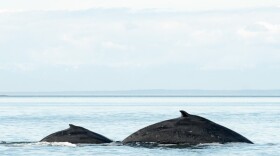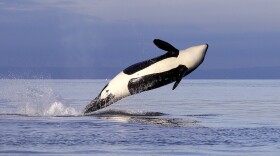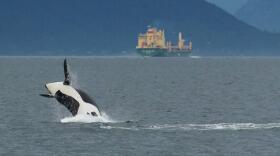-
The majority of captains of big commercial ships entering and leaving Puget Sound are cooperating with a request to slow down temporarily to reduce underwater noise impacts to the Pacific Northwest's critically endangered killer whales. The duration of the experimental slowdown – modeled on a similar project in British Columbia – will be extended into the new year, organizers announced after a status report and celebration on the Seattle waterfront Friday.
-
Fortunately, it doesn't happen very often in the Pacific Northwest that ships collide with whales. But when it does, it's upsetting, tragic and the whale probably dies. Three separate teams have developed smartphone-based systems that can alert commercial mariners to watch out, slow down or change course when whales have been sighted nearby. A recent ride-along on a big container ship demonstrated that real-time whale alerts are still a work in progress.
-
Whale watchers have spotted a record number of humpback calves in inland Pacific Northwest waters this season. There was also a record streak of Bigg's killer whale sightings that just ended, according to a local whale research nonprofit. Those observations offer some good news to offset the ongoing concern about the survival of the Northwest's iconic, but critically endangered resident orcas.
-
By analyzing the DNA of orca feces as well as salmon scales and other remains after the whales have devoured the fish, the researchers demonstrated that the while the whales sometimes eat other species, including halibut, lingcod and steelhead, they depend most on Chinook. And they consumed the big salmon from a wide range of sources — from those that spawn in California's Sacramento River all the way to the Taku River in northern British Columbia.
-
According to the rules approved by the commission last week, from July through September, commercial whale watching companies can view endangered Southern Resident orcas during two, two-hour periods daily, The Skagit Valley Herald reported.
-
After four years of study, the Record of Decision makes the federal agencies’ preferred option official. Managers and dam supporters say it will benefit salmon, reliable hydropower and the economy. Wild salmon advocates, tribal representatives and renewable energy advocates say this decision will hurt salmon and the orcas that depend on them for food.
-
Debates have dragged on for decades about whether to remove or alter the four dams. The Army Corps, Bureau of Reclamation and Bonneville Power Administration received almost 59,000 comments on the draft EIS this spring. The agencies are expected to finalize this plan by Sept. 30.
-
A dam removal that has been 20 years in the making reached an important milestone this week. Explosives ripped through the concrete on the Middle Fork Nooksack, east of Bellingham.
-
American and Canadian marine scientists -- and one talented dog -- are seizing an unexpected opportunity presented by the coronavirus pandemic. They are trying to establish whether Pacifc Northwest whales benefit from the current drop in boat traffic and underwater noise.
-
The U.S. Army Corps of Engineers, Bureau of Reclamation and Bonneville Power Administration laid out a range of six alternatives in a draft environmental impact statement. The most controversial measure would have been to remove or alter the four Lower Snake River dams.
Play Live Radio
Next Up:
0:00
0:00
Available On Air Stations








